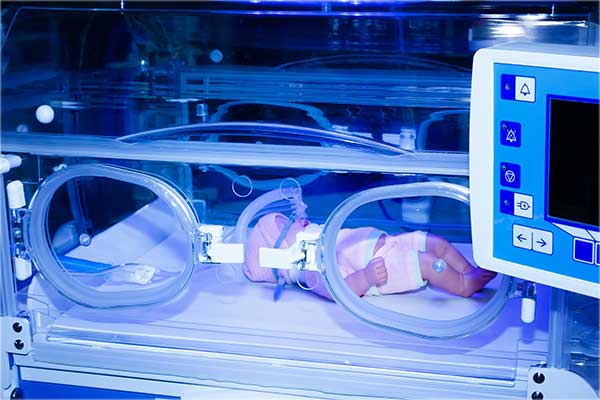
Measurement of Effective Irradiance in Bilirubin Phototherapy
Blue light phototherapy is widely used for the treatment for neonatal hyperbilirubinaemia, a condition in which there is too much bilirubin in the blood. This causes a yellowing of the infant’s skin, known as jaundice. Effective phototherapy requires sufficiently high irradiance with appropriate wavelengths, generally accepted as ‘blue light’ over a large effective treatment area.
Neonatal phototherapy has been widely used for more than 50 years employing many lighting technologies including various fluorescent tube types, tungsten halogen and metal halide lamps as well as LED based units which are becoming increasingly commonplace. This diverse range of treatment lamps produces widely differing spectral outputs. Unfortunately, there is no universally accepted ‘action spectra’ or agreement on the most effective wavelengths which has resulted in rather poor quality dosimetry and radiometry in this field over the years.
Standards for Bilirubin Measurements
The standard IEC EN 60601-2-50:2009+A1:2016 [1] defines total irradiance for bilirubin, Ebi where:
Ebi = integrated irradiance 400 nm to 550 nm, generally reported in mW/cm2.
No wavelength preference is given thereby accommodating many different lamp types. The standard also defines that the minimum integrated irradiance, Ebi MIN, needs to be greater than 40% of the maximum, Ebi MAX, value over the effective treatment area. Manufacturers are also required to ensure UV and IR emissions are within strict limits (see Optical Radiation Hazard Applications).
However, the most recent guidelines issued by the American Academy of Pediatrics [2] in 2011 recommend ‘intensive phototherapy’ resulting from average spectral irradiance levels over the 460 to 490nm spectral range exceeding 30 µW/cm2/nm. Previously, the AAP guidelines had referenced the same irradiance level but over a wider wavelength band of 430 nm to 490 nm. Intensities above 65 µW/cm2/nm may be considered potentially harmful however.
Manufacturers have also chosen to select their own wavelength range over which to specify the average spectral irradiance of their products, with 425 nm to 475nm being widely used for example. In practice, radiometers do not have perfectly flat spectral responses over their desired wavelength band and also suffer from out of band responsivity. Therefore, radiometers can only measure with good accuracy if used to measure a phototherapy treatment lamp with spectral distribution closely matching that for which it was calibrated [3].
Measurement Equipment for Bilirubin Measurements
Consequently, optimising treatment dosimetry and agreement on best practises as well as medical research have all been hindered by the large variability of measurement data produced by the many proprietary broadband radiometers employed, each with its specific spectral response and typically tailored to specific lamp or LED types. The MSC15 spectral light meter and its for Bilirubin optimized version MSC15-Bili conveniently and effectively eliminates these issues [4]. For flexible detector usage see our CSS-45-Bili with CSS-D. It measures the actual spectral irradiance produced by the lamp and provides display modes in accordance with the latest standards and guidance, irrespective of the lamp type or manufacturer. It directly displays total irradiance for bilirubin, Ebi (mW/cm2) in accordance with IEC 60601-2-50:2009+A1:2016 as well as average spectral irradiance (µW/cm2/nm) in accordance with the latest AAP recommendations. Full spectral data is also available enabling matching to any proprietary wavelength band specified by a manufacturer.
References
[1] IEC 60601-2-50:2009+A1:2016 Medical electrical equipment - Part 2-50: Particular requirements for the basic safety and essential performance of infant phototherapy equipment.
[3] Neonatal phototherapy radiometers: Current performance characteristics and future requirements